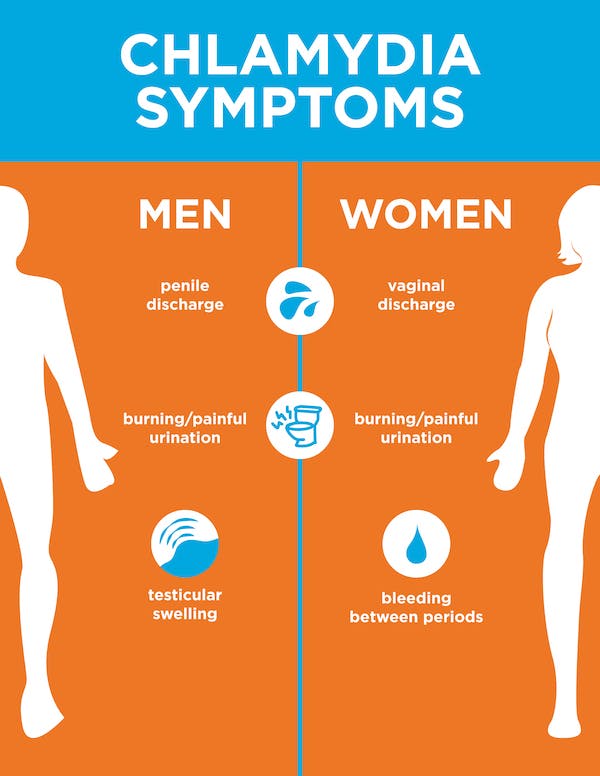Chlamydia symptoms: What to look for and where to get help
Chlamydia is the most commonly reported sexually transmitted disease (STD) in the United States and affects both men and women. This stealthy bacterial infection is easily spread through oral, vaginal, or anal sex.
Although easily treated, chlamydia can be difficult to detect because infected individuals rarely experience symptoms or they show mild signs of chlamydia which are easily mistaken for other conditions. If chlamydia is left untreated, the disease can have serious, lifelong consequences, such as infertility and pelvic inflammatory disease for women.
Because chlamydia is a “silent” STD, regular STD checks and well-woman visits are a must if you’re sexually active.
Lifecycle of chlamydia trachomatis
Chlamydia is caused by a strain of bacteria called Chlamydia trachomatis. During sexual contact with an infected person, the bacteria can enter the body through the urethra, rectum, or mouth. The bacteria can also be spread to the eyes through body fluids and cause an infection similar to pink eye.
Most people with chlamydia don’t know they have it. In fact, about 75 percent of women and 50 percent of men show no signs of chlamydia. For this reason, chlamydia spreads easily and may be unknowingly passed to sexual partners.
When chlamydia symptoms do occur, they are usually noticeable within one to three weeks of contact. These symptoms may be mistaken for other conditions or disappear after a few weeks.
If chlamydia is left untreated, it can lead to serious complications. Although both men and women are diagnosed with sexually transmitted infections (STIs) such as chlamydia in equal numbers, they are not affected equally.
Women are more likely than men to experience long-term health complications from an untreated chlamydia infection, including pelvic inflammatory disease, peritonitis, and other infections that can lead to infertility or complications during pregnancy. Pregnant women can also pass chlamydia to babies during pregnancy or childbirth.
It’s rare for men to experience long-term complications from a chlamydia infection. However, the infection can spread to the testicles and impact fertility.
The chlamydia symptoms you may experience depend on the part of the body infected. Let’s review possible chlamydia symptoms in both men and women.

Chlamydia symptoms in men
The following symptoms can be signs of chlamydia in men:
- Pain or burning during urination
- Burning and itching around the opening of the penis
- Clear or cloudy discharge from the tip of the penis
- Pain and swelling around the testicles
- Rectal pain or bleeding
- Lower abdominal pain
- Painful sex
- Inflamed eye
Chlamydia symptoms in women
Chlamydia symptoms in women include the following:
- Abnormal vaginal discharge that may have an unusual odor
- Bleeding between periods
- Painful periods
- Abdominal pain with fever
- Pain during sex
- Itching or burning in or around the vagina
- Painful urination
- Rectal pain or discharge
- Inflamed eye
Less common chlamydia symptoms may include sore throat, right upper abdominal pain, or joint pain.
Women should be aware that other sexually transmitted infections can also cause changes in vaginal discharge. Visiting a healthcare provider for STD testing is the only way to know if you have chlamydia or whether another condition is causing your vaginal discharge symptoms.
Is chlamydia an STD or STI?
Since chlamydia is a bacterial infection transmitted during sexual acts and is easily treated with medicine, it is technically an STI.
STD is short for sexually transmitted disease, and STI stands for sexually transmitted infection. The terms are often used interchangeably to describe any health condition spread through sexual contact, but there is a difference.
Infections are usually easily treated with medication, like chlamydia. While STDs are chronic and require long-term medical management.
STIs are infections caused by bacteria or viruses exchanged during sexual contact. When diagnosed and treated early, these infections rarely cause long-lasting symptoms. When an STI goes untreated, it can lead to a disease state, with severe symptoms and impaired body functions.
What does chlamydia look like?
Discharge and inflammation are the most common visible signs of chlamydia.
Both men and women can experience abnormal discharge from their genitals due to chlamydia infection. This may look like this:
- Odorous yellowish, white, or gray discharge from the vagina
- Watery or mucus-like discharge from the tip of the penis
- Discharge from the anus
Inflammation caused by chlamydia can present as redness or swelling around the affected body part (i.e., vagina, penis, testicles, anus, or eyes)
Chlamydia causes
The bacteria that causes chlamydia is exchanged through vaginal secretions and semen. Any sexual contact that involves an exchange of these body fluids can cause chlamydia. This includes sexual intercourse, anal sex, oral sex, or sharing sex toys.
Chlamydia can also be spread via the hands. If your hands come into contact with infected body fluid(s) during sexual acts, chlamydia can spread to the genitals or eye(s) if you touch them without first washing your hands.
Pregnant women infected with chlamydia can pass the infection to their babies during childbirth. Chlamydia is not exchanged through saliva, nasal mucus, or respiratory droplets.
How to tell your partner you have chlamydia
If you’re diagnosed with chlamydia or any other STI, the responsible thing to do is inform your partner(s) right away. Contact your sexual partner(s), let them know what you’ve tested positive for, and request that they get tested as soon as possible. Early testing for chlamydia is essential to prevent the continued spread and long-term consequences.
It may feel uncomfortable to talk about STIs with your partner, but it’s necessary for the health of both of you.
Is chlamydia curable?
Chlamydia can be treated with oral antibiotics such as azithromycin or doxycycline, which a doctor can prescribe at urgent care.
If you’ve been diagnosed with chlamydia, you may wonder how long it takes for chlamydia symptoms to go away. The good news is once you start treatment, chlamydia symptoms disappear in about two days and the infection clears up in one to two weeks.
If you have chlamydia, your partner(s) should also be treated with antibiotics to prevent reinfection and further spread.
After taking antibiotics, you should be retested after three months to be sure the infection is cured. It’s important to abstain from sex until both you and your partner are sure you no longer have chlamydia.
Chlamydia symptoms related to other conditions
Untreated chlamydia can lead to more serious health conditions such as pelvic inflammatory disease, infertility, or arthritis. If you have had an undetected chlamydia infection for a while, you may experience the following:
- Chronic pain in the pelvic and/or lower abdominal region
- Increased risk of ectopic pregnancy
- Pre-term pregnancy
- Difficulty getting pregnant
- Inflammation, pain, and/or stiffness in the joints
If you’re experiencing any of these symptoms, you should see a healthcare provider for treatment and identify the underlying cause.
Get tested for STIs/STDs at urgent care
If you or your partner show any signs of chlamydia or any STI, you should get tested right away, especially if you’re pregnant.
If you’re sexually active, you should schedule regular STD/STI checks. Women under 25 are especially vulnerable to chlamydia, so it’s important for them to get checked annually at their well-woman visit. Pregnant women should be tested for chlamydia regardless of their sexual history.
Testing is especially important if you’ve had unprotected sex or if you’re sexually active and not in a mutually monogamous relationship. You may not experience any symptoms of an STD/STI, but getting tested can catch a silent infection before it impacts your health.
At urgent care, STD/STI testing includes a physical exam, as well as blood and urine tests. In some cases, the doctor will use a swab to collect a sample from the affected area.
If you need to get checked for chlamydia or any other STD/STI, come see the experts at one of our urgent care locations. You can walk in without an appointment, or save your spot online. We’ll have you back to feeling better in no time.
Written by Sarah Thebarge, Physician Assistant


